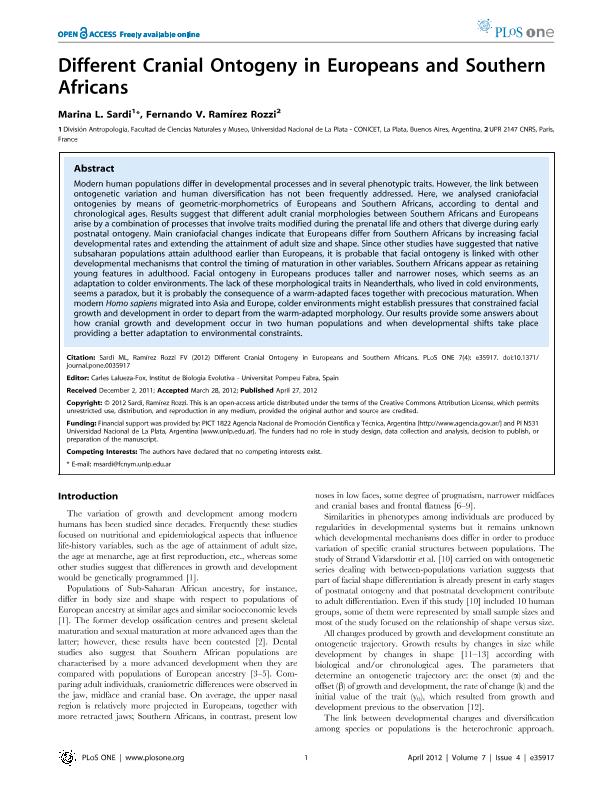Mostrar el registro sencillo del ítem
dc.contributor.author
Sardi, Marina Laura

dc.contributor.author
Ramírez Rozzi, Fernando V.
dc.date.available
2019-05-08T23:21:01Z
dc.date.issued
2012-04
dc.identifier.citation
Sardi, Marina Laura; Ramírez Rozzi, Fernando V.; Different Cranial Ontogeny in Europeans and Southern Africans; Public Library of Science; Plos One; 7; 4; 4-2012; 1-12
dc.identifier.issn
1932-6203
dc.identifier.uri
http://hdl.handle.net/11336/75931
dc.description.abstract
Modern human populations differ in developmental processes and in several phenotypic traits. However, the link between ontogenetic variation and human diversification has not been frequently addressed. Here, we analysed craniofacial ontogenies by means of geometric-morphometrics of Europeans and Southern Africans, according to dental and chronological ages. Results suggest that different adult cranial morphologies between Southern Africans and Europeans arise by a combination of processes that involve traits modified during the prenatal life and others that diverge during early postnatal ontogeny. Main craniofacial changes indicate that Europeans differ from Southern Africans by increasing facial developmental rates and extending the attainment of adult size and shape. Since other studies have suggested that native subsaharan populations attain adulthood earlier than Europeans, it is probable that facial ontogeny is linked with other developmental mechanisms that control the timing of maturation in other variables. Southern Africans appear as retaining young features in adulthood. Facial ontogeny in Europeans produces taller and narrower noses, which seems as an adaptation to colder environments. The lack of these morphological traits in Neanderthals, who lived in cold environments, seems a paradox, but it is probably the consequence of a warm-adapted faces together with precocious maturation. When modern Homo sapiens migrated into Asia and Europe, colder environments might establish pressures that constrained facial growth and development in order to depart from the warm-adapted morphology. Our results provide some answers about how cranial growth and development occur in two human populations and when developmental shifts take place providing a better adaptation to environmental constraints.
dc.format
application/pdf
dc.language.iso
eng
dc.publisher
Public Library of Science

dc.rights
info:eu-repo/semantics/openAccess
dc.rights.uri
https://creativecommons.org/licenses/by/2.5/ar/
dc.subject
Development
dc.subject
Heterochrony
dc.subject
Adaptation
dc.subject.classification
Historia

dc.subject.classification
Historia y Arqueología

dc.subject.classification
HUMANIDADES

dc.title
Different Cranial Ontogeny in Europeans and Southern Africans
dc.type
info:eu-repo/semantics/article
dc.type
info:ar-repo/semantics/artículo
dc.type
info:eu-repo/semantics/publishedVersion
dc.date.updated
2019-05-06T13:39:29Z
dc.journal.volume
7
dc.journal.number
4
dc.journal.pagination
1-12
dc.journal.pais
Estados Unidos

dc.journal.ciudad
San Francisco
dc.description.fil
Fil: Sardi, Marina Laura. Universidad Nacional de La Plata. Facultad de Ciencias Naturales y Museo. Departamento Científico de Arqueología; Argentina. Consejo Nacional de Investigaciones Científicas y Técnicas. Centro Científico Tecnológico Conicet - La Plata; Argentina
dc.description.fil
Fil: Ramírez Rozzi, Fernando V.. Centre National de la Recherche Scientifique; Francia
dc.journal.title
Plos One

dc.relation.alternativeid
info:eu-repo/semantics/altIdentifier/url/http://www.plosone.org/article/info%3Adoi%2F10.1371%2Fjournal.pone.0035917
dc.relation.alternativeid
info:eu-repo/semantics/altIdentifier/doi/http://dx.doi.org/10.1371/journal.pone.0035917
Archivos asociados
